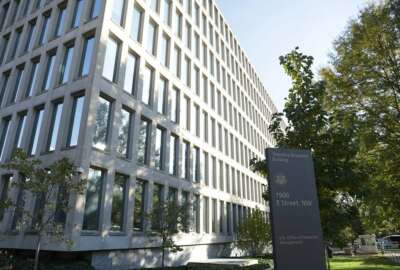OPM lays out hybrid ‘future of work’ vision for agencies
The Office of Personnel Management launches a five-pronged strategy aiming to help agencies better adapt to the increasing prevalence of hybrid work for the federal...
Agencies are continuing to move toward a new era for the federal workforce, one that has become colloquially known as the “future of work.”
To help them get there, agencies have new information from the Office of Personnel Management, which has outlined a vision for what that future of work should look like.
“We endeavor to position the federal government as a model employer that empowers the workforce to solve our nation’s toughest challenges,” OPM Director Kiran Ahuja said in a March 7 memo to agency heads. “OPM is committed to supporting and strengthening agencies to ensure they are resilient for the future while continuing to achieve their respective missions in service of the people and communities they serve.”
OPM’s new strategy for the federal future of work emphasizes the role of remote work and telework, as well as the increasingly common hybrid work environment, which incorporates a mix of in-person and virtual employees. The strategy also hinges on helping agencies with workforce planning, in an effort to support a workforce that’s now operating much differently than it was just a couple of years ago.
“The work environment fundamentally transformed, with planned virtual catch-up sessions replacing hallway conversations,” Ahuja said.
Working in tandem with agency chief human capital officers (CHCOs), OPM launched a five-part strategy, aiming to help agencies with their long-term strategic workforce planning.
The five priorities are:
- Policy and resources
- Research and evaluation
- Training and technical assistance
- Data analytics
- Stakeholder engagement
Ahuja said the five priorities should serve as a “north star” for agencies’ workforce management and strategies — they are an effort to create an “inclusive, agile and engaged” federal workforce.
The future of work strategy is not a new policy, but rather guidance from OPM to help agencies as they continue to make adjustments in long-term workforce planning. The strategy also builds off of OPM’s 2021 update to federal telework guidance, which took into account the significant changes that came as a result of the COVID-19 pandemic.
Within each of the five priorities, OPM said there are ongoing efforts to help agencies, with more coming down the pipeline. For policy and resources, for example, agencies already have access to an office re-entry checklist from OPM, tip sheets for hybrid workforce management and a remote work tagging option on USA Jobs.
Agencies will see new resources from OPM on a future of work website moving forward, to help agencies navigate a hybrid work environment.
Additionally, agency leaders and supervisors will soon get access to free training sessions from OPM on how to effectively manage employees in a hybrid work environment.
“In addition, OPM will continue to provide ongoing training and consulting services on key workforce and human capital management topics aligned to the future of the workforce to ensure agencies have timely and useable resources,” OPM said.
Among the other priorities in the new strategy, OPM said it also plans to work with research partners to consider their studies on hybrid work when publishing new guidance or policies. Federal unions, organizations and other stakeholders in federal human capital management will be able to work with OPM to help inform the agency’s future policies and programs that involve the federal workforce.
Another goal from OPM is to provide agencies with more data analytics, such as public-facing dashboards.
OPM is in the process of developing several dashboards for agencies, including a Federal Employee Viewpoint Survey (FEVS) dashboard, as well as a CHCO hiring manager satisfaction dashboard. The dashboards will present data on employee retention, attrition, engagement and recruitment, which agencies can then use for human capital planning and requirements under the President’s Management Agenda (PMA).
“In addition to thinking about where we work and how we work, agencies need to be forecasting how missions will evolve, the type of work to be done, the skills needed for the future, and the steps in the process of building inclusive and engaged work environments as they build their future of the workforce strategies,” Ahuja said. “As agencies develop their own strategies, we encourage you to identify meaningful metrics that provide measures and targets for organization performance that lead to mission delivery.”
Changes to remote work data reporting
OPM also announced more upcoming requirements for agencies to report data on each federal employees’ participation in telework and remote work.
The goal is to help agencies make more informed decisions for workforce planning, by having more information on remote work and telework available to them. The announcement also reaffirms OPM’s push to expand telework and remote work flexibilities for agencies when possible.
“These new data elements will provide deeper and improved granularity into understanding the workforce characteristics,” Ahuja said in a March 7 memo. “Once implemented, they have the potential to improve governmentwide reporting of federal employee participation in remote work, telework and mobile work, as well as allow OPM to evaluate trends and determine how such work arrangements might advance the accomplishment of mission-critical requirements and organizational effectiveness.”
Specifically, agencies and shared service providers will soon have to report on whether employees are working on a remote work or a telework agreement, or neither, as a way for human resources departments to keep track. Additionally, agencies will have to report both instances and hours of remote work per pay period, to record the frequency of remote work across each agency.
For the federal workforce, there is a distinction between a telework and remote work. Teleworking employees must report to work both at an agency worksite and alternative worksite on a regular and recurring basis each pay period. Remote employees can work from an alternative worksite with no expectation of coming into the office.
The new data reporting from agencies will feed directly into OPM’s Enterprise Human Resources Integration (EHRI) data files, providing an exact number of employees in each work category. The EHRI system can then list the information by different workforce factors, for example, by occupation.
“We have heard from the agencies, through ongoing reentry support activities, that having more refined data related to telework and remote work will assist you in evaluating how employee work arrangements are impacting key workforce considerations — such as productivity, recruitment and retention — that are critical to successful organizational performance,” Ahuja said.
OPM is currently working with agencies to determine a timeline for implementing the new data reporting requirements.
Copyright © 2025 Federal News Network. All rights reserved. This website is not intended for users located within the European Economic Area.
Drew Friedman is a workforce, pay and benefits reporter for Federal News Network.
Follow @dfriedmanWFED
Related Stories





